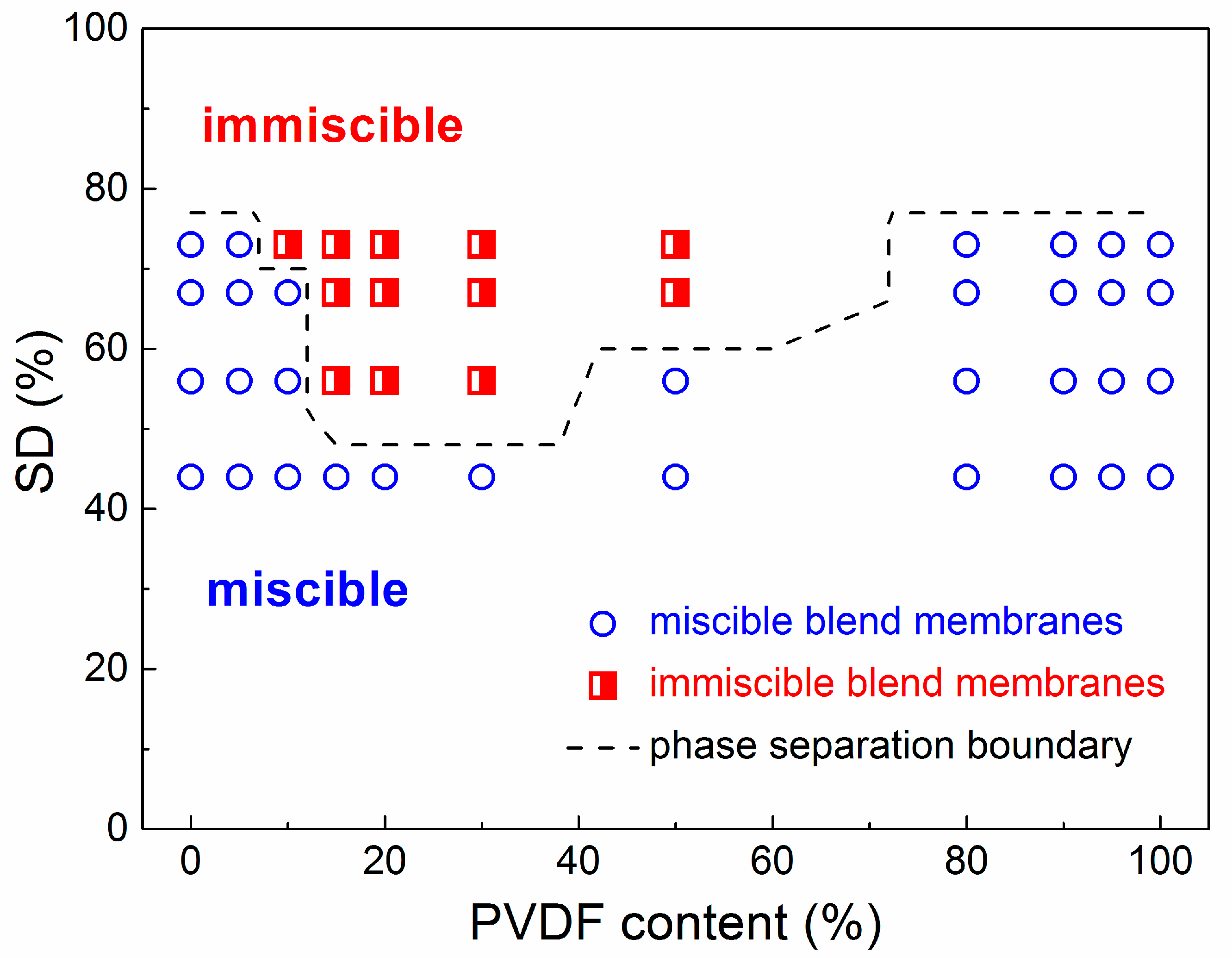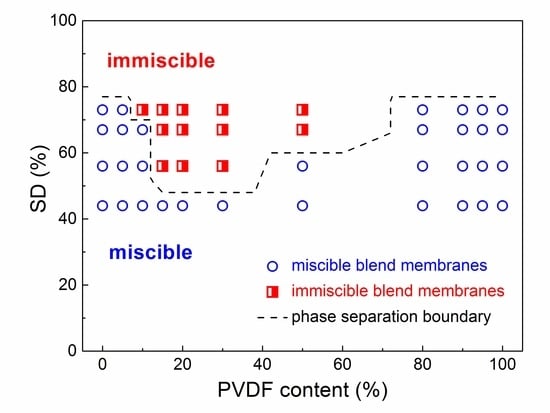Effect of Sulfonation Degree and PVDF Content on the Structure and Transport Properties of SPEEK/PVDF Blend Membranes
Abstract
1. Introduction
2. Experimental
2.1. Materials
2.2. Preparation of SPEEK and SPEEK/PVDF Blend Membranes
2.3. Measurements
3. Results and Discussion
3.1. Microstructure of Blend Membranes
3.2. DSC Analysis
3.3. Proton Conductivity
3.4. Methanol Permeability
4. Conclusions
Author Contributions
Acknowledgments
Conflicts of Interest
References
- Scofield, M.E.; Liu, H.; Wong, S.S. A concise guide to sustainable PEMFCs: Recent advances in improving both oxygen reduction catalysts and proton exchange membranes. Chem. Soc. Rev. 2015, 44, 5836–5860. [Google Scholar] [CrossRef] [PubMed]
- Nasef, M.M. Radiation-Grafted Membranes for Polymer Electrolyte Fuel Cells: Current Trends and Future Directions. Chem. Rev. 2014, 114, 12278–12329. [Google Scholar] [CrossRef]
- Wei, Z.; He, S.J.; Liu, X.; Qiao, J.; Lin, J.; Zhang, L.Q. A Novel Environment-friendly Route to Prepare Proton Exchange Membranes for Direct Methanol Fuel Cells. Polymer 2013, 54, 1243–1250. [Google Scholar] [CrossRef]
- Awang, N.; Jaafar, J.; Ismail, A.F. Thermal Stability and Water Content Study of Void-Free Electrospun SPEEK/Cloisite Membrane for Direct Methanol Fuel Cell Application. Polymers 2018, 10, 194. [Google Scholar] [CrossRef]
- Wang, H.; Li, X.X.; Li, X.J.; Feng, X.; Kang, W.M.; Xu, X.L.; Zhuang, X.P.; Cheng, B.W. Self-Assembly DBS Nanofibrils on Solution-Blown Nanofibers as Hierarchical Ion-Conducting Pathway for Direct Methanol Fuel Cells. Polymers 2018, 10, 1037. [Google Scholar] [CrossRef] [PubMed]
- He, S.J.; Lin, Y.K.; Wei, Z.; Zhang, L.Q.; Lin, J.; Nazarenko, S. Solvent-free Fabrication of Proton Conducting Membranes Based on Commercial Elastomers. Polym. Advan. Technol. 2015, 26, 300–307. [Google Scholar] [CrossRef]
- Sasikala, S.; Meenakshi, S.; Bhat, S.D.; Sahu, A.K. Functionalized Bentonite clay-SPEEK based composite membranes for direct methanol fuel cells. Electrochim. Acta 2014, 135, 232–241. [Google Scholar] [CrossRef]
- Ma, L.Y.; Xu, G.X.; Li, S.; Ma, J.; Li, J.; Cai, W.W. Design and Optimization of a Hyper-Branched Polyimide Proton Exchange Membrane with Ultra-High Methanol-Permeation Resistivity for Direct Methanol Fuel Cells Applications. Polymers 2018, 10, 1175. [Google Scholar] [CrossRef] [PubMed]
- Liu, X.; He, S.J.; Song, G.; Jia, H.N.; Shi, Z.Z.; Liu, S.X.; Zhang, L.Q.; Lin, J. Proton Conductivity Improvement of Sulfonated Poly(ether ether ketone) Nanocomposite Membranes with Sulfonated Halloysite Nanotubes Prepared via Dopamine-Initiated Atom Transfer Radical Polymerization. J. Membr. Sci. 2016, 504, 206–219. [Google Scholar] [CrossRef]
- He, S.J.; Liu, S.X.; Dai, W.X.; Zhai, S.X.; Lin, J. Nanocomposite Proton Exchange Membranes Incorporating Phosphotungstic Acid Anchored on Imidazole-Functionalized Halloysite Nanotubes. J. Electrochem. Soc. 2018, 165, F951–F958. [Google Scholar] [CrossRef]
- Shin, D.W.; Guiver, M.D.; Lee, Y.M. Hydrocarbon-Based Polymer Electrolyte Membranes: Importance of Morphology on Ion Transport and Membrane Stability. Chem. Rev. 2017, 117, 4759–4805. [Google Scholar] [CrossRef] [PubMed]
- He, S.J.; Dai, W.X.; Yang, W.; Liu, S.X.; Bian, X.M.; Zhang, C.; Lin, J. Nanocomposite proton exchange membranes based on phosphotungstic acid immobilized by polydopamine-coated halloysite nanotubes. Polym. Test. 2019, 73, 242–249. [Google Scholar] [CrossRef]
- Zhai, S.X.; Dai, W.X.; Lin, J.; He, S.J.; Zhang, B.; Chen, L. Enhanced Proton Conductivity in Sulfonated Poly(ether ether ketone) Membranes by Incorporating Sodium Dodecyl Benzene Sulfonate. Polymers 2019, 11, 203. [Google Scholar] [CrossRef]
- He, S.J.; Lin, Y.K.; Ma, H.F.; Jia, H.N.; Liu, X.; Lin, J. Preparation of sulfonated poly(ether ether ketone) (SPEEK) membrane using ethanol/water mixed solvent. Mater. Lett. 2016, 169, 69–72. [Google Scholar] [CrossRef]
- Bakangura, E.; Wu, L.; Ge, L.; Yang, Z.J.; Xu, T.W. Mixed matrix proton exchange membranes for fuel cells: State of the art and perspectives. Prog. Polym. Sci. 2016, 57, 103–152. [Google Scholar] [CrossRef]
- Li, Z.H.; Xi, J.Y.; Zhou, H.P.; Liu, L.; Wu, Z.H.; Qiu, X.P.; Chen, L.Q. Preparation and characterization of sulfonated poly(ether ether ketone)/poly(vinylidene fluoride) blend membrane for vanadium redox flow battery application. J. Power Sources 2013, 237, 132–140. [Google Scholar] [CrossRef]
- Sung, K.A.; Kim, W.K.; Oh, K.H.; Choo, M.J.; Nam, K.W.; Park, J.K. Stability enhancement of polymer electrolyte membrane fuel cells based on a sulfonated poly(ether ether ketone)/poly(vinylidene fluoride) composite membrane. J. Power Sources 2011, 196, 2483–2489. [Google Scholar] [CrossRef]
- Jung, H.Y.; Park, J.K. Blend membranes based on sulfonated poly(ether ether ketone) and poly(vinylidene fluoride) for high performance direct methanol fuel cell. Electrochim. Acta 2007, 52, 7464–7468. [Google Scholar] [CrossRef]
- Ren, S.Z.; Sun, G.Q.; Li, C.N.; Wu, Z.M.; Jin, W.; Chen, W.M.; Xin, Q.; Yang, X.F. Sulfonated poly (ether ether ketone)/polyvinylidene fluoride polymer blends for direct methanol fuel cells. Mater. Lett. 2006, 60, 44–47. [Google Scholar] [CrossRef]
- Wootthikanokkhan, J.; Seeponkai, N. Methanol permeability and properties of DMFC membranes based on sulfonated PEEK/PVDF blends. J. Appl. Polym. Sci. 2006, 102, 5941–5947. [Google Scholar] [CrossRef]
- Jung, H.Y.; Park, J.K. Long-term performance of DMFC based on the blend membrane of sulfonated poly(ether ether ketone) and poly(vinylidene fluoride). Int. J. Hydrogen Energy 2009, 34, 3915–3921. [Google Scholar] [CrossRef]
- Xue, S.; Yin, G.P.; Cai, K.D.; Shao, Y.Y. Permeabilities of methanol, ethanol and dimethyl ether in new composite membranes: A comparison with Nafion membranes. J. Membr. Sci. 2007, 289, 51–57. [Google Scholar] [CrossRef]
- Inan, T.Y.; Dogan, H.; Unveren, E.E.; Eker, E. Sulfonated PEEK and fluorinated polymer based blends for fuel cell applications: Investigation of the effect of type and molecular weight of the fluorinated polymers on the membrane’s properties. Int. J. Hydrogen Energy 2010, 35, 12038–12053. [Google Scholar] [CrossRef]
- Xue, S.N.; Yin, G.P. Proton exchange membranes based on poly(vinylidene fluoride) and sulfonated poly(ether ether ketone). Polymer 2006, 47, 5044–5049. [Google Scholar] [CrossRef]
- Liu, X.; He, S.J.; Liu, S.X.; Jia, H.N.; Chen, L.; Zhang, B.; Zhang, L.Q.; Lin, J. The roles of solvent type and amount of residual solvent on determining the structure and performance of sulfonated poly(ether ether ketone) proton exchange membranes. J. Membr. Sci. 2017, 523, 163–172. [Google Scholar] [CrossRef]
- Gu, S.; He, G.H.; Wu, X.M.; Hu, Z.W.; Wang, L.L.; Xiao, G.K.; Peng, L. Preparation and characterization of poly(vinylidene fluoride)/sulfonated poly(phthalazinone ether sulfone ketone) blends for proton exchange membrane. J. Appl. Polym. Sci. 2010, 116, 852–860. [Google Scholar] [CrossRef]
- Cappadonia, M.; Erning, J.W.; Niaki, S.M.S.; Stimming, U. Conductance of Nafion 117 membranes as a function of temperature and water content. Solid State Ion. 1995, 77, 65–69. [Google Scholar] [CrossRef]
- Park, C.H.; Lee, C.H.; Guiver, M.D.; Lee, Y.M. Sulfonated hydrocarbon membranes for medium-temperature and low-humidity proton exchange membrane fuel cells (PEMFCs). Prog. Polym. Sci. 2011, 36, 1443–1498. [Google Scholar] [CrossRef]






| Sulfonation Time (h) | IEC (mmol g−1) | SD (%) |
|---|---|---|
| 12 | 1.33 | 44 |
| 17 | 1.64 | 56 |
| 36 | 1.89 | 67 |
| 48 | 2.01 | 73 |
| PVDF Content (%) | SPEEK44/PVDF | SPEEK73/PVDF | ||||
|---|---|---|---|---|---|---|
| Melting Point (°C) | Melting Enthalpy (J·g−1) | PVDF Crystallinity (%) | Melting Point (°C) | Melting Enthalpy (J·g−1) | PVDF Crystallinity (%) | |
| 0 | - | 0 | 0 | - | 0 | 0 |
| 5 | 172.0 | 0.38 | 7 | 171.4 | 0.91 | 17 |
| 10 | 172.8 | 1.27 | 12 | 172.0 | 2.00 | 19 |
| 15 | 173.5 | 2.54 | 16 | 172.4 | 3.87 | 25 |
| 20 | 173.2 | 4.16 | 20 | 171.7 | 6.10 | 29 |
| 30 | 172.9 | 8.72 | 29 | 173.2 | 11.9 | 38 |
| 50 | 173.7 | 17.0 | 33 | 172.4 | 21.8 | 41 |
| 80 | 174.1 | 34.9 | 42 | 172.5 | 36.1 | 43 |
| 90 | 176.3 | 42.3 | 45 | 174.0 | 41.2 | 44 |
| 95 | 175.5 | 43.1 | 44 | 173.2 | 43.0 | 43 |
| 100 | 174.8 | 47.8 | 46 | 174.8 | 47.8 | 46 |
© 2019 by the authors. Licensee MDPI, Basel, Switzerland. This article is an open access article distributed under the terms and conditions of the Creative Commons Attribution (CC BY) license (http://creativecommons.org/licenses/by/4.0/).
Share and Cite
He, S.; Zhai, S.; Zhang, C.; Xue, Y.; Yang, W.; Lin, J. Effect of Sulfonation Degree and PVDF Content on the Structure and Transport Properties of SPEEK/PVDF Blend Membranes. Polymers 2019, 11, 676. https://doi.org/10.3390/polym11040676
He S, Zhai S, Zhang C, Xue Y, Yang W, Lin J. Effect of Sulfonation Degree and PVDF Content on the Structure and Transport Properties of SPEEK/PVDF Blend Membranes. Polymers. 2019; 11(4):676. https://doi.org/10.3390/polym11040676
Chicago/Turabian StyleHe, Shaojian, Shaoxiong Zhai, Chong Zhang, Yang Xue, Wei Yang, and Jun Lin. 2019. "Effect of Sulfonation Degree and PVDF Content on the Structure and Transport Properties of SPEEK/PVDF Blend Membranes" Polymers 11, no. 4: 676. https://doi.org/10.3390/polym11040676
APA StyleHe, S., Zhai, S., Zhang, C., Xue, Y., Yang, W., & Lin, J. (2019). Effect of Sulfonation Degree and PVDF Content on the Structure and Transport Properties of SPEEK/PVDF Blend Membranes. Polymers, 11(4), 676. https://doi.org/10.3390/polym11040676







